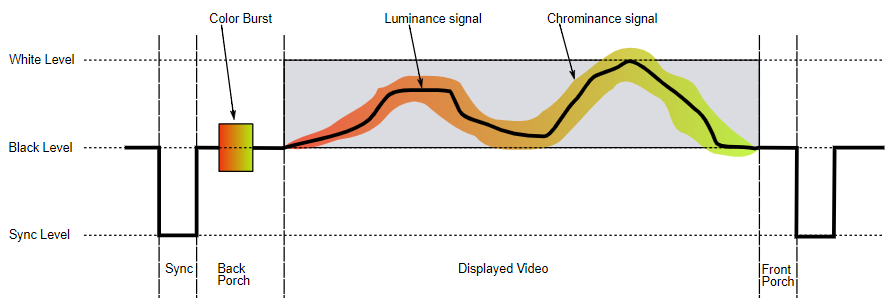No.
A generated video signal will always be within the limits on the appropriate screen. If not, it will be due a misaligned (*1) display - or using a non fitting display, which is the same.
Keep in mind, especially when including monitors (that is devices not tied to any TV standard), there are no limits other than the ones set by its manufacturer. Any combination of line length, lines per frame and frames per second is possible. There is no right or wrong.
<Background_Information>
Common for all of these, the (composite) video signal for each line follows the same definition of Front Porch, Sync, Back Porch and Display Area as this nice picture shows:
 (Taken from Wikipedia)
(Taken from Wikipedia)
The Display Area is the part of the signal that is meant for display. It is fixed within the appropriate production line. For US TV production (60 Hz 525 lines) it's 52.6 µs, for European 50Hz/625 lines it's 52 µs. Anything longer will result in an invalid picture, everything shorter needs to be filled up (*2).
Early (hobby) machines often used the whole display area, leading to a picture creeping deep into the edges (*3) Later (home-) computers used in most cases only a section of the display area due various reasons (*4). The remainder was usually filled with their background colour (like white on a ZX81) or even offered to select a certain colour/brightness (think VC20).
Computers always outputed the whole area. It was up to the user to adjust the TV set in a way to emphase on the variable content or not.
Later the ability to cover the whole display area with more than just a border was sold as a 'new/additional' feature - more of a marketing move ignoring the past than anything really new.
</Background_Information>
So in any case, the display area of a composite signal is always the same and intended to be fully displayed. What part of the signal is finally shown is not determinated by the computer or it's video hardware, thus it can't be influenced by either. it's strictly an issue of (faulty) display setup.
Bottom line: The question is not about computing but display properties and a faulty setup thereof.
Note: The issue of Title Safe and Action Safe area are sometimes mentioned in this context (likewise Overscan, Underscan or Fullscan). Except, they are neither part of any of TV/CRT technology or relevant for a correct adjusted display. They are purely hints for TV producers where to place which content, to increase the chance that a transmission gets show even on malaligned TV sets. There is no guarantee for either to be helpful or to matter at all. For a computer setup a correct adjusted screen is default (and mandatory).
*1 - Or on purpose aligned that way. So if you see pictures using the screen way into the edge, it's because the user has adjusted the screen to show it that way, not because the computer did so.
*2 - By default in black, but any other intensity/colour is valid as well.
*3 - Noteworthy the TV dazzler with producing the whole display area from memory data - a fact that made it quite useful and a defacto standard in late 1970s early 1980s TV production.
*4 - Beside the intention to produce a certain pixel ratio, more often than not it was the same as with TV: staying within an area even quite old TV and/or less than perfect aligned TV will show without the need to be adjusted. It's all about user experience, isn't it? And having to adjust the TV set is no considered a perfect one - no matter how habdly adjusted it already is.

